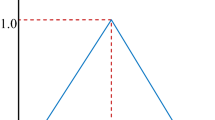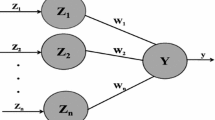Abstract
Over the years, numerous fuzzy time-series forecasting (FTSF) models have been developed to handle the uncertainty and non-determinism in the time-series (TS) data. To handle the non-determinism and indeterminacy, researchers have considered either intuitionistic fuzzy set or hesitant fuzzy set theory. However, in both the fuzzy set theories (FST), the degree of indeterminacy is a dependent value and always lies in the range [0, 1]. Hence, these two fuzzy set theories fail to model the indeterminacy value when the degree of non-membership fluctuates due to hesitancy. Motivated from this, we have considered neutrosophic entropy-based fuzzy time-series forecasting (NEBFTSF) model where the neutrosophic entropy of each observation in the TS is used to capture the indeterminacy. Apart from this, the triangular membership value for each observation is used to illustrate the non-probabilistic uncertainty in the TS. The present research mainly focuses on three concepts such as 1) an adaptive method is used to partition the universe of discourse (UOD) into unequal length of intervals (LOIs), 2) for the first time the fuzzy logical relationships (FLRs) are established by considering the ratio trend variation (RTV) data with mean of aggregated entropy value of each crisp observation, and 3) to obtain the forecasted values both de-trending and de-normalization are employed. To assess the forecasting performance of the proposed model, 11 TS datasets with ten distinct profound forecasting models are considered. The Friedman and Nemenyi hypothesis test and Wilcoxon signed rank test conform the forecasting efficiency and reliability of the NEBFTSF model.

















Similar content being viewed by others
References
Zadeh, L.A.: Fuzzy sets. Information Control. 338–353 (1965). Doi: https://doi.org/10.1109/2.53
Song, Q.; Chissom, B.S.: Forecasting enrollments with fuzzy time series - Part I. Fuzzy Sets and Syst. (1993). https://doi.org/10.1016/0165-0114(93)90355-L
Song, Q.; Chissorn, B.S.: Forecasting enrollments with fuzzy time series-part II. Fuzzy Sets Syst. 62, 1–8 (1994)
Sullivan, J.; Woodall, W.H.: A comparison of fuzzy forecasting and Markov modeling. Fuzzy Sets Syst. 64, 279–293 (1994). https://doi.org/10.1016/0165-0114(94)90152-X
Chen, S.M.: Forecasting enrollments based on fuzzy time series. Fuzzy Sets Syst. 81, 311–319 (1996). https://doi.org/10.1016/0165-0114(95)00220-0
Chen, S.M.: Forecasting enrollments based on high-order fuzzy time series. Cybern. Syst. 33, 1–16 (2002). https://doi.org/10.1080/019697202753306479
Own, C.M.; Yu, P.T.: Forecasting fuzzy time series on a heuristic high-order model. Cybern. Syst. 36, 705–717 (2005). https://doi.org/10.1080/01969720591008922
Atanassov, K.T.: Intuitionistic fuzzy sets. Fuzzy Sets Syst. 20, 87–96 (1986). https://doi.org/10.1016/S0165-0114(86)80034-3
Gangwar, S.S.; Kumar, S.: Probabilistic and intuitionistic fuzzy sets-based method for fuzzy time series forecasting. Cybern. Syst. 45, 349–361 (2014). https://doi.org/10.1080/01969722.2014.904135
Joshi, D.K.; Kumar, S.: Entropy of interval-valued intuitionistic hesitant fuzzy set and its application to group decision making problems. Granul. Comput. 3, 367–381 (2018). https://doi.org/10.1007/s41066-018-0077-6
Kumar, S.; Gangwar, S.S.: A fuzzy time series forecasting method induced by intuitionistic fuzzy sets. Int. J. Model. Simul. Scientific Comput. 6, 1550041 (2015). https://doi.org/10.1142/S1793962315500415
Kumar, S.; Gangwar, S.S.: Intuitionistic fuzzy time series: An approach for handling nondeterminism in time series forecasting. IEEE Transactions Fuzzy Syst. 24, 1270–1281 (2016). https://doi.org/10.1109/TFUZZ.2015.2507582
Pattanayak, R.M.; Behera, H.S.; Panigrahi, S.: A novel probabilistic intuitionistic fuzzy set based model for high order fuzzy time series forecasting. Eng. Appl. Artif. Intell. 99, 104136 (2021). https://doi.org/10.1016/j.engappai.2020.104136
Torra, V., Narukawa, Y.: On hesitant fuzzy sets and decision. IEEE International Conference on Fuzzy Systems. 1378–1382 (2009). https://doi.org/10.1109/FUZZY.2009.5276884
Torra, V.: Hesitant fuzzy sets. Int. J. Intell. Syst. 25, 529–539 (2010). https://doi.org/10.1002/int.20418
Chen, S.M.; Hong, J.A.: Multicriteria linguistic decision making based on hesitant fuzzy linguistic term sets and the aggregation of fuzzy sets. Information Sci. 286, 63–74 (2014). https://doi.org/10.1016/j.ins.2014.06.020
Lee, L.W.; Chen, S.M.: Fuzzy decision making based on likelihood-based comparison relations of hesitant fuzzy linguistic term sets and hesitant fuzzy linguistic operators. Information Sci. 294, 513–529 (2015). https://doi.org/10.1016/j.ins.2014.09.061
Bisht, K.; Kumar, S.: Fuzzy time series forecasting method based on hesitant fuzzy sets. Expert Syst. Appl. 64, 557–568 (2016). https://doi.org/10.1016/j.eswa.2016.07.044
Smarandache, F.: Neutrosophic set – a generalization of The intuitionistic fuzzy set. Int. J. Pure Appl. Math. 24, 287–297 (2005)
Wang, H.; Smarandache, F.; Zhang, Y.Q.; Sunderraman, R.: Single valued neutrosophic sets. Multispace Multistructure. 4, 410–413 (2010)
Zhang, H.; Wang, J.; Chen, X.: Interval neutrosophic sets and their application in multicriteria decision making problems. Scientific World J. 2014, 1–15 (2014). https://doi.org/10.1155/2014/645953
Cheng, H.; Guo, Y.: A new neutrosophic approach to image thresholding. New Math Natural Comput. 04, 291–308 (2008). https://doi.org/10.1142/S1793005708001082
Deli, I., Ali, M., Smarandache, F.: Bipolar neutrosophic sets and their application based on multi-criteria decision making problems. In: 2015 International Conference on Advanced Mechatronic Systems (ICAMechS). pp. 249–254. IEEE (2015)
Ye, J.: Multicriteria decision-making method using the correlation coefficient under single-valued neutrosophic environment. Int J. Gen. Syst. 42, 386–394 (2013). https://doi.org/10.1080/03081079.2012.761609
Lotfi, F.H.; Fallahnejad, R.: Imprecise Shannon’s entropy and multi attribute decision making. Entropy 12, 53–62 (2010). https://doi.org/10.3390/e12010053
Szmidt, E.; Kacprzyk, J.: Entropy for intuitionistic fuzzy sets. Fuzzy Sets Syst. 118, 467–477 (2001). https://doi.org/10.1016/S0165-0114(98)00402-3
Singh, P.; Huang, Y.-P.: A high-order neutrosophic-neuro-gradient descent algorithm-based expert system for time series forecasting. Int. J. Fuzzy Syst. 21, 2245–2257 (2019). https://doi.org/10.1007/s40815-019-00690-2
Gupta, K.K.; Kumar, S.: A novel high-order fuzzy time series forecasting method based on probabilistic fuzzy sets. Granul. Comput. 4, 699–713 (2019). https://doi.org/10.1007/s41066-019-00168-4
Wang, Y.; Lei, Y.; Fan, X.; Wang, Y.: Intuitionistic fuzzy time series forecasting model based on intuitionistic fuzzy reasoning. Math. Problems Eng. 2016, 1–12 (2016). https://doi.org/10.1155/2016/5035160
Pattanayak, R.M., Behera, H.S., Rath, R.K.: A Higher Order Neuro-Fuzzy Time Series Forecasting Model Based on Un-equal Length of Interval. In: International Conference on Application of Robotics in Industry using Advanced Mechanisms. pp. 34–45 (2020)
Pattanayak, R.M.; Behera, H.S.; Panigrahi, S.: A multi-step-ahead fuzzy time series forecasting by using hybrid chemical reaction optimization with pi-sigma higher-order neural network. In: Das, A., Nayak, J., Naik, B., Pati, S., Pelusi, D. (eds.) Computational Intelligence in Pattern Recognition, pp. 1029–1041. Springer, Singapore (2020)
Pattanayak, R.M.; Behera, H.S.; Panigrahi, S.: A novel hybrid differential evolution-PSNN for fuzzy time series forecasting. In: Behera, H., Nayak, J., Naik, B., Pelusi, D. (eds.) Computational Intelligence in Data Mining, pp. 675–687. Springer, Singapore (2020)
Huarng, K.: Effective lengths of intervals to improve forecasting in fuzzy time series. Fuzzy Sets Systs. 123, 387–394 (2001). https://doi.org/10.1016/S0165-0114(00)00057-9
Huarng, K.; Yu, T.H.K.: Ratio-based lengths of intervals to improve fuzzy time series forecasting. IEEE Transactions Syst Man Cybern Part B: Cybern. 36, 328–340 (2006). https://doi.org/10.1109/TSMCB.2005.857093
Panigrahi, S.; Behera, H.S.: A study on leading machine learning techniques for high order fuzzy time series forecasting. Eng. Appl. Artif. Intell. 87, 103245 (2020). https://doi.org/10.1016/j.engappai.2019.103245
Yu, T.H.K.; Huarng, K.H.: A neural network-based fuzzy time series model to improve forecasting. Expert Syst. Appl. 37, 3366–3372 (2010). https://doi.org/10.1016/j.eswa.2009.10.013
Cagcag Yolcu, O.; Lam, H.K.: A combined robust fuzzy time series method for prediction of time series. Neurocomputing 247, 87–101 (2017). https://doi.org/10.1016/j.neucom.2017.03.037
Cortes, C.; Vapnik, V.: Support-vector networks. Mach. Learn. 20, 273–297 (1995). https://doi.org/10.1007/BF00994018
Vapnik, V.N.: The Nature of Statistical Learning Theory. Statistics for Engineering and Information Science, Springer, New York (2000)
Tsang, I.W.; Kwok, J.T.; Cheung, P.M.: Core vector machines: Fast SVM training on very large data sets. J. Mach. Learn. Res. 6, 363–392 (2005)
Aladag, C.H.; Basaran, M.A.; Egrioglu, E.; Yolcu, U.; Uslu, V.R.: Forecasting in high order fuzzy times series by using neural networks to define fuzzy relations. Expert Syst. Appl. 36, 4228–4231 (2009). https://doi.org/10.1016/j.eswa.2008.04.001
Aladag, C.H.: Using multiplicative neuron model to establish fuzzy logic relationships. Expert Syst. Appl. 40, 850–853 (2013). https://doi.org/10.1016/j.eswa.2012.05.039
Bas, E.; Grosan, C.; Egrioglu, E.; Yolcu, U.: High order fuzzy time series method based on pi-sigma neural network. Eng. Appl. Artif. Intell. 72, 350–356 (2018). https://doi.org/10.1016/j.engappai.2018.04.017
Gupta, K.K.; Kumar, S.: Hesitant probabilistic fuzzy set based time series forecasting method. Granul. Comput. 4, 739–758 (2019). https://doi.org/10.1007/s41066-018-0126-1
Demšar, J.: Statistical comparisons of classifiers over multiple data sets. J. Mach. Learn. Res. 7, 1–30 (2006)
Author information
Authors and Affiliations
Corresponding author
Rights and permissions
About this article
Cite this article
Pattanayak, R.M., Behera, H.S. & Panigrahi, S. A Non-Probabilistic Neutrosophic Entropy-Based Method For High-Order Fuzzy Time-Series Forecasting. Arab J Sci Eng 47, 1399–1421 (2022). https://doi.org/10.1007/s13369-021-05718-0
Received:
Accepted:
Published:
Issue Date:
DOI: https://doi.org/10.1007/s13369-021-05718-0




